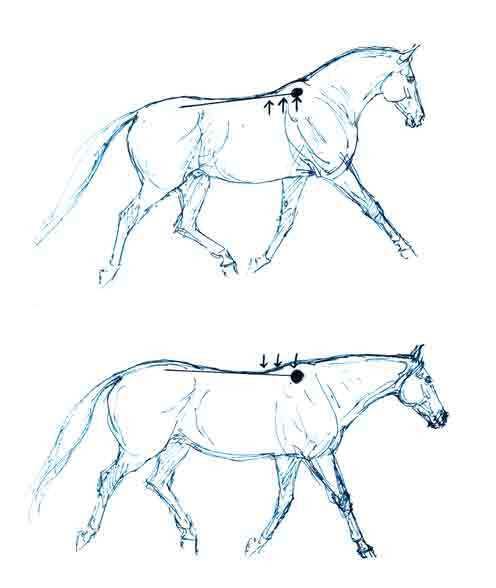 | ||
Collection occurs when a horse carries more weight on the hind legs than the front legs. The horse draws its body together so that it becomes like a giant spring whose stored energy can be reclaimed for fighting or running from a predator. The largest organic spring in the horse's body, and therefore the easiest one to observe in action, is the back, including the spine and the associated musculature that draws it together in much the same way that a bow is drawn by an archer.
Contents
Collection and the wild horse
Collection of the horse's body is an important mechanism for survival. If danger suddenly appears the horse has a large store of energy ready for instantaneous release and so it is much easier for it to spring away from the danger than if it had been caught flat-footed, or "on the forehand."
When a strange horse comes upon the scene, when a horse catches the scent of a predator, or when a horse scents a potential mate, the attention of the horse is naturally aroused and its body prepares for action. It raises its head, arches its back, and in so doing brings its legs more under its body where they can maintain the bending of the spine by their contact with the earth. With each step forward this spring is released slightly and then immediately re-compressed.
Collection in riding
Collection is also an important ingredient in riding, if the rider wishes to perform more advanced movements or jumping. It not only allows the horse to move more easily and athletically, but also helps prevent wear-and-tear on the front legs. Through training, the horse learns to collect itself when requested to do so by the rider. The observer receives the impression of great strength held under perfect control.
The most readily apparent form of collection can be observed when comparing different degrees of collection within a single gait. A more collected gait will have two main symptoms: the horse will lower his hindquarters and raise his forehand, and the horse will have more bend in the joints of his legs. Additionally, the stride length will be shortened. Collection may be performed at any gait.
However, this does not mean that any shortened gait is collected. Riders who try to pull their horses into a shortened gait (riding "front-to-back"), rather than contain the energy coming from the hindquarters (riding "back-to-front"), will produce a shortened stride, but the horse will continue to carry his weight on his front end, and will simply have stiff, unathletic movement. The shoulders will not be raised, and the horse will find it more difficult to perform a task than he would otherwise. The hind legs will usually be "strung out behind," rather than coming up under the body with each stride to support it, and the back will be dropped rather than properly raised upward.
Specific uses in sport
Collected gaits are asked for in dressage tests from the mid-levels upward, at the walk, trot, and canter. Additionally, a high degree of collection is required of the rider in more advanced dressage moves, such as the pirouette, piaffe, and passage. The ultimate level of collection is the levade, in which the horse carries 100% of his weight on his hindquarters. Unlike a rearing horse, the horse's rear legs are well under it, and it can safely support itself in an upright position for a time and then lower itself to the ground under control.
Collection is also essential in jumping. Most horses will physically be unable to jump extremely high fences (such as those seen in Grand Prix show jumping or puissance classes) without collection, as they will not have enough power to make it over the obstacle. Speed is not a substitute, and a horse that is simply galloped at a fence will find it extremely difficult to raise his forehand upward on takeoff and gain enough height over the fence. Instead, he will jump flat, without bascule, and will be much more likely to pull a rail. Secondly, horses must be adjustable within jumping courses, having the ability to shorten or lengthen their stride between obstacles, especially if placed in a combination. A horse that is not collected will find it very hard to seamlessly shorten his stride in a related distance, and may be forced to take off too close or too far away from the jump, which greatly increases the chance he will hit it.
Collection also makes it easier for a horse to make sudden changes of direction, such as those required by western performance horses. Cutting horses are excellent examples, as they crouch low and back on their hindquarters so they may quickly move side to side to mirror the movements of the calf.
